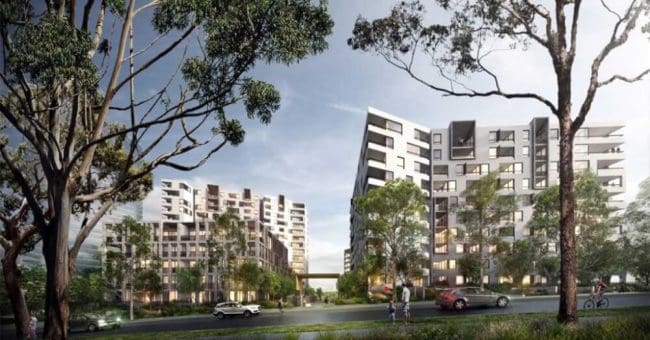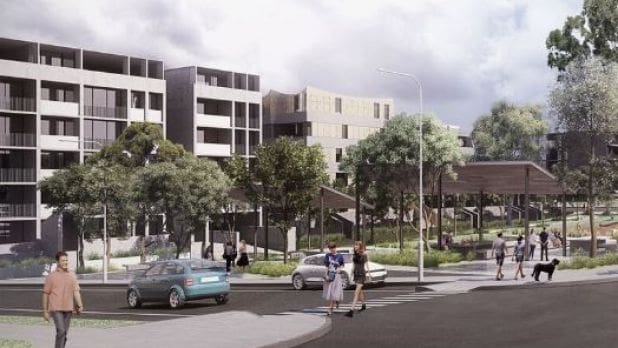Elsewhere in this post
The NSW government is getting behind build-to-rent housing in a big way, announcing major changes to tax and planning policies to encourage developers to build apartment blocks that will be for renters only, with resident owners and investors locked out.
As described previously in these pages, build-to-rent is a system whereby an apartment block or even townhouses are all owned by a single entity, there is no owners corporation or strata committee, and tenants are offered much longer leases.
It’s an increasingly popoular model for tenants who don’t want two levels of hassles in their lives – landlords and strata committees – and are prepared to pay more for better facilities.
It eventually could and probably should lead to changes in the ways individual investor owners engage with their apartment committees
NSW Treasurer Dominic Perrottet and Minister for Planning and Public Spaces Rob Stokes this week announced changes to planning and tax policies intended to boost building – and therefore the economy – while at the same time offering more choice for renters.
“To encourage more build-to-rent housing there will be a discount equivalent to at least a 50 per cent reduction on land tax and an exemption from foreign investor surcharges for eligible build-to-rent developments until 2040,” Mr Perrottet said.
For developments to benefit from the changes, they must contain at least 50 homes specifically for the purposes of build-to-rent and offer tenants a range of lease term choices, including a genuine option to enter into a fixed term lease of at least three years.
The blocks must be held by one company or entity and must not be subdivided in the first 15 years of receiving the concessions.
Third option
Build-to-rent is seen as a third option for renters. They are neither private rentals owned by individual private investors, nor are they housing commission units owned and run by the government.
They won’t come under strata law – because they are not strata – but they will still be governed by the Residential Tenancies Act.
“We’ve levelled the playing field so build-to-rent developments will see similar overall amounts of State tax as comparable build-to-sell developments,” said Mr Perrottet.
“We’re leading the way in Australia when it comes to build-to-rent housing, making it easier for more people to have access to housing that suits their needs. We would welcome support from the Federal Government to supplement these vital reforms through their own policies.”
Build-to-rent is often mistakenly conflated with the idea of affordable housing but the models operating in Australia so far have tended to be the opposite – slightly higher rents paying for much better communal facilities on longer leases.
However, the Treasury guidelines on tax exemptions specifically cites affordable housing as being part of the build-to-rent mix, saying build-to-rent properties must comply with any relevant affordable housing policies that may be imposed under the Environmental Planning and Assessment Act.
Charms race
Also, build-to-rent properties will be exempt from requirements that they must be managed by a single management entity with on-site access to management for tenants, provided those specific dwellings are made available for use as affordable housing or social housing for a continuous period of 15 years.
This seems to be opening the door for NSW Housing or housing charities to be invest in a chunk of apartments in a build-to-rent block and even be involved in the management those properties.
If so, that will run counter to the current trend of a “charms race” where developers like Mirvac, in their Liv Indigo development at Olympic Park, set out to provide much better facilities than even top-end strata schemes offer, with the aim of attracting and holding on to better, longer-term tenants.
And that’s what could shake up the way investors connect with their strata owners and committee. Right now, many buildings are dominated by investors, many of whom either take a hands-off approach or who insist on paring back levies to the minimum, to protect their profits.
However, if there is a drift of renters to better-managed blocks with more attractive facilities, individual investors may decide to get more involved and seek more imaginative ways of protecting their investments than just cutting costs.
But all that remains to be seen. One benefit for build-to-renters is that they don’t have to worry about the effects on their landlord of, say, building defects. The builders and developers will own the defects so they are likely to try to keep them to a minimum.
Launching the tax and planning breaks, Minister Stokes said it was crucial to remove barriers and allow the build-to-rent market to grow, supporting jobs and ensuring more people had access to a variety of housing options.
Boom and bust
“As our housing system evolves to better meet the needs of NSW households and families, it’s critical our planning system is responsive and flexible to new development models,” Mr Stokes said.
“For too long our housing market has ridden the boom and bust cycle, and build-to-rent housing can offer longer term certainty for renters and investors alike.
“These changes are a critical step in our plan to simplify the planning system to support investment and growth in the wake of the pandemic.”
The build-to-rent planning changes are effective immediately and will be included in the new consolidated Housing State Environmental Planning Policy (SEPP), which will be finalised in the coming months.
Meanwhile a report from property marketting giants CBRE reveals that the number of build-to-rent projects in the pipeline has increased by almost 70 percent in the past year, with 40 projects and the total number of units approaching 15,000 – a new high for the asset class.
“As the pipeline continues to expand, the aggregate size of the market is currently estimated to exceed $10 billion, with an additional $3-5 billion in projects currently under consideration or at various stages of due diligence,” says a CBRE press release.
This follows a 28% increase in new projects in the second half of last year relative to the first six months of 2020.
For more information about the NSW proposals you can read the planning policy here. And for an insight into Build-To-Rent have a listen to our podcasts recorded when we visited Mirvac’s new Liv Indigo development HERE and HERE.





If you want to start a discussion or ask a question about this, log into the Flat Chat Forum (using the Forum link on the menu at the very top of your screen). More people will read it there and you can more easily keep track of responses.